Physical Address
304 North Cardinal St.
Dorchester Center, MA 02124
Always consider an ostial lesion as a possible bifurcation lesion, except in cases of aortoostial location.
A 6-Fr guiding catheter is appropriate most of the time; when in doubt, use 7- or 8-Fr.
Do not risk losing the side branch (SB); when in doubt, always protect it with a wire.
If there are difficulties wiring the SB, consider dilating the main branch first.
Provisional stenting does not mean accepting a poor final result for an important SB.
Treatment of a bifurcation lesion with two stents (main and SBs) is an acceptable approach.
Do not forget the final kissing inflation preceded by high-pressure inflation on the SB when implanting two stents.
When dedicated drug-eluting stent (DES) for bifurcation lesions become available, many concepts may change, including the emergence of a more liberal usage of a two-stent strategy.
Optimal antiplatelet therapy is always a key factor for short- and long-time success: keep yourself updated for new developments.
A bifurcation coronary lesion is a lesion occurring at, or adjacent to, a significant division of a major epicardial coronary artery. Coronary bifurcation lesions have been the subject of several classifications, with the underlying assumption that each type could be associated with a specific treatment. However, attempts to classify bifurcation lesions suffer all the limitations of coronary angiography (different plaque distribution and extent of disease when evaluated by intravascular ultrasound [IVUS]). At the present time, there are six different classifications of bifurcation lesions ( Fig. 23.1 ). The most important distinction to is to divide bifurcation lesions into “true” bifurcations, where the main branch (MB) and the side branch (SB) are both significantly narrowed (>50% diameter stenosis), and “nontrue” bifurcations, which include all the other lesions involving a bifurcation. In routine practice, the “Medina” classification is still the most simplified and widely used approach to classify distribution of atherosclerotic plaque at bifurcation site. The presence of “1” means >50% diameter stenosis and “0” the absence of stenosis, in each of the three bifurcation segments, starting with proximal MB, distal MB, and proximal SB: 1,1,1 when there is a critical stenosis in all three segments and 1,1,0 when only the proximal and distal MB are affected. Many other combinations are possible. A limitation of the Medina classification is that the length of the stenosis involving the SB is not specified and we think that this distinction is a key element to properly plan the treatment.
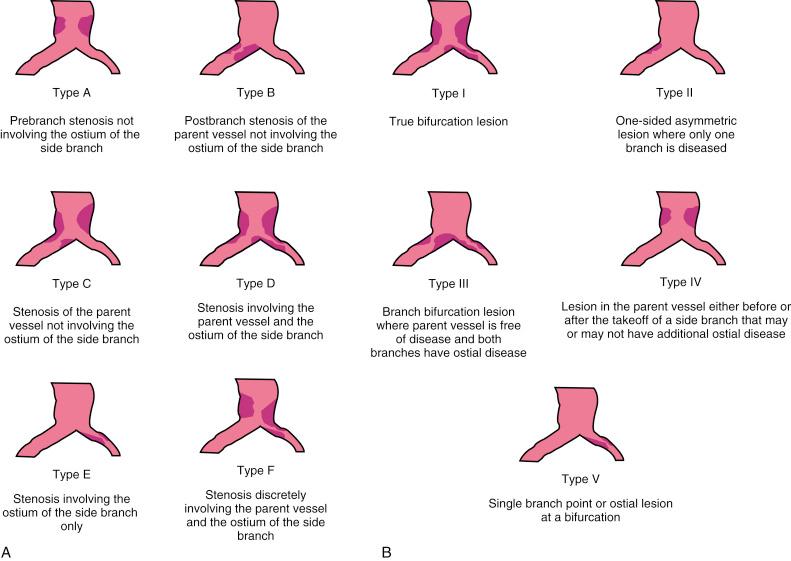
Despite an array of devices available, stenting utilizing drug-eluting stent (DES) remains the default approach to treat bifurcation lesions, and the implantation of a single stent on the MB is the most widely used approach.
Several major randomized trials comparing one or two stents in the treatment of coronary bifurcations demonstrated that the implantation of a stent only in the MB remains the preferred strategy.
The sirolimus-eluting stent (SES) bifurcation study was the first attempt to provide specific information in this subset of lesions. Eighty-five patients were randomly assigned to either stenting both branches or stenting the MB only with provisional stenting (PS) of the SB. Data were analyzed by actual treatment received, not by intention-to-treat. Crossover rate was very high, 51.2% in the provisional group and 4.7% in the two-stent group. Restenosis at 6 months did not differ significantly between the stent/stent (28.0%) and the stent/percutaneous transluminal coronary angioplasty (18.7%) groups ( P = .53). During the 6-month follow-up, there was no significant difference between groups in death, myocardial infarction (MI), target-vessel revascularization (TVR), or target-vessel failure (19.0% vs. 13.6%). Therefore, this study demonstrated that compared with historical studies utilizing bare-metal stents, a clear improvement has been achieved in the treatment of bifurcation lesions when one or two DESs were implanted.
In a second study, Pan and coworkers compared two strategies for the SES treatment of bifurcation lesions in 91 patients with “true” coronary bifurcation lesions. Six-month major adverse cardiac events (MACEs) and restenosis rate of the MB and of the SB were similar in the two study groups.
A third randomized study was the Nordic Bifurcation Study (Nordic), in which 413 patients were randomized to two stents ( n = 206) or PS ( n = 207) with SES implantation. The crossover from provisional to stenting two branches was allowed if thrombolysis in myocardial infarction (TIMI) flow following SB dilation was 0 and was only 4.3%. At 6 months, there was no difference between the two groups regarding cardiac death, MI, index lesion MI, TVR, target-lesion revascularization (TLR) and stent thrombosis (ST). At 5-year follow-up, the combined safety and efficacy end point of cardiac death, nonprocedure-related MI, and TVR remained similar and were seen in 15.8% of patients in the PS group, as compared with 21.8% in the two-stent group ( P = .15).
In a fourth trial, Bifurcations Bad Krozingen (BBK) study, Ferenc et al. compared 202 patients randomly allocated to either provisional T stenting or routine T stenting utilizing SES. Primary end point was percent diameter stenosis of the SB at 9-month angiographic follow-up, and was similar between the two groups ( P = .15). The overall 1-year incidence of TLR after provisional and routine T stenting was also similar, as well as the primary clinical outcome (composite of death, MI, TLR was 12.9% vs. 11.9%, P = .83).
In the CACTUS trial (Coronary Bifurcations: Application of the Crushing Technique Using Sirolimus-Eluting Stents), 350 patients were randomly allocated to either provisional T or crush SES implantation, with mandatory final kissing balloon inflation (FKBI) in both groups. Stent implantation in the SB was allowed by the T stenting technique only when at least 1 of the following conditions was met: residual stenosis ≥50%, dissection of type B or worse, or TIMI flow ≤2. A high proportion of patients (92%) had true bifurcations, and crossover rate in the provisional T group was 31%. The primary angiographic end point was the in-segment restenosis rate, and the primary clinical end point was the 6-month rate of MACEs (cardiac death, MI, or TVR). At 6 months, angiographic restenosis rates were not different between the crush group (4.6% and 13.2% in the MB and SB, respectively) and the PS group (6.7% and 14.7% in the MB and SB, respectively; P = not significant [NS]). The primary clinical outcome (death, MI, revascularization) was also similar in both groups (15.0% provisional vs. 15.8% crush, P = NS).
In the BBC ONE study (British Bifurcation Coronary Study: Old, New, and Evolving Strategies), 500 patients were randomly allocated to either a simple strategy (minimalist provisional T) or a complex strategy (either crush or culotte) using paclitaxel-eluting stents (PESs). In the simple strategy, the MB was stented, followed by optional kissing balloon dilatation/T stent utilizing the following criteria: TIMI flow <3 in the SB, severe ostial pinching of the SB (>90%), threatened SB closure, or SB dissection greater than type A. Only 30% of SB underwent further treatment after MB stenting (27% balloon dilatation and 3% stenting). In the complex strategy, both branches were systematically stented (culotte or crush techniques) with mandatory kissing balloon dilatation. At 9-month clinical follow-up, there was a significant difference between the two groups in terms of death, MI, or revascularization (simple 8.0% vs. complex 15.5%). This difference was largely driven by the higher incidence of MI in the complex group (11.2% vs. 3.6%, P = .001). It is quite surprising to note the very high number of complications that occurred in patients randomized to the complex strategy.
The DKCRUSH-II (Double Kissing Crush Versus Provisional Stenting Technique for Treatment of Coronary Bifurcation Lesions) trial investigated the difference in MACE (cardiac death, MI, or TVR) at 12 months in 370 patients with coronary bifurcation lesions after double kissing crush (DK-crush) or PS techniques. MACE and definite ST rates were similar between the DK (10.3% and 2.2%) and PS groups (17.3% and 0.5%, P = .070 and P = .372, respectively). However, angiographic restenosis rates in the main vessel (MV), and the SB were lower in the DK group (3.8% and 4.9%) than the PS group (9.7% and 22.2%, P = .036 and P < .001, respectively), as well as TVR (6.5% vs. 14.6%, P = .017). At 5 years, MACE tended to occur more frequently in patients treated with a provisional strategy, as opposed to DK-crush (23.8% vs. 15.7%, P = .051). TLR rate was higher in patients with PS versus DK-crush (16.2% vs. 8.6%, P = .027), particularly in patients with anatomically more complex lesions.
Most recently, the DKCRUSH-V (Double Kissing Crush Versus Provisional Stenting for Left Main Distal Bifurcation Lesions) randomized trial showed a reduction in a 12-month target lesion failure (TLF) rate with DK-crush versus PS (5.0% vs. 10.7%, P = .02) in patients with true distal left main (LM) bifurcation lesions. DK-crush was associated with a tendency toward less clinically driven TLR (3.8 vs. 7.9%, P = .06), and surprisingly, it also resulted in lower rates of MI (0.4% vs. 2.9%, P = .03) and ST (0.4% vs. 3.3%, P = .02).
The clinical implication of these trials is that in most cases, provisional rather than elective stenting of the SB should be performed. PS appears less expensive and simpler, and can be performed with less contrast and in a shorter procedural time. At the same time, the evidence of comparable results in the two arms does not contradict the choice of crush/culotte stenting in selected cases with complex anatomy or with diffuse disease on the SB. The consensus from available randomized trials was that routine two-vessel stenting did not improve either angiographic or clinical outcomes for most patients with coronary bifurcation lesions, although routine dual vessel stenting did not involve a significant penalty either.
One shortcoming of these trials was that the treatment groups including two stents were heterogeneous, and the techniques used may have resulted in different clinical outcomes.
Clinical outcomes in randomized trials comparing one- versus two-stent strategies in non-LM bifurcations are presented in Fig. 23.2 .
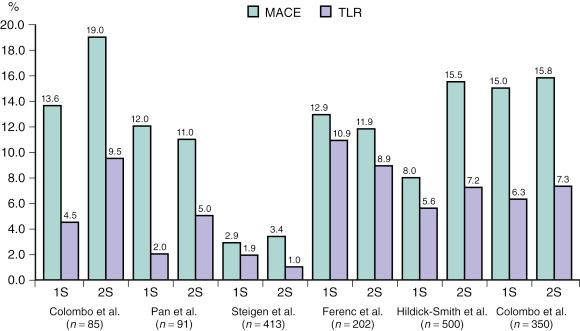
To evaluate the impact of specific two-stent technique, the Nordic complex bifurcation stenting study was performed. In this investigation, 424 patients were randomized to either crush or culotte stenting utilizing SES (77% of which were “true” coronary bifurcation lesions). At 6-month clinical follow-up, there was no difference between the two groups in terms of death, postprocedure MI, or revascularization (the primary end point: crush 4.3% vs. culotte 3.7%, P = .87). However, there was a trend for a higher incidence of periprocedural MI and significantly higher occurrence of in-stent restenosis in the crush group (crush 10.5% vs. culotte 4.5%, P = .046). Clinical outcomes remained similar at 3-year follow-up in the crush and the culotte groups, with MACE rates of 20.6% versus 16.7% ( P = .32).
The DKCRUSH-III study investigated the difference in MACE rates at 1-year after DK crush and Culotte stenting in 419 patients with unprotected left main coronary artery (LMCA) distal bifurcation lesions. Patients in the Culotte group had higher 1-year MACE rate compared with the DK group (16.3% vs. 6.2%, P = .001), which was mainly driven by increased TVR rate (11.0% vs. 4.3%, P = .016). In all prespecified subsets, patients with bifurcation angle ≥70 degrees, NERS (New Risk Stratification) score ≥20, and SYNTAX (Synergy between Percutaneous Coronary Intervention with Taxus and Cardiac Surgery) score ≥23, MACE rates at 1 year were consistently lower in the DK group. At 3 years, the occurrence of MACE remains more frequent in the culotte versus DK-crush group (23.7% vs. 8.2%, P < .001), mainly driven by a higher rate of TVR (18.8% vs. 5.8%, P < .001) and MI (8.2% vs. 3.4%, P = .037). Interestingly, the rate of definite ST was 3.4% in patients treated with culotte, whereas no definite ST was documented in the DK-crush group (0.007).
In the BBK II trial, 300 patients with bifurcation lesions requiring SB stenting were randomized to undergo T stenting and small protrusion (TAP) or culotte stenting. Nine-month angiographic follow-up, which was available for 91% of the patients, revealed higher binary restenosis rate after TAP as compared with culotte (17.0% vs. 6.5%, P = .006), whereas the 1-year incidence of TLR was 12% in the TAP group and 6% in the culotte group ( P = .069).
To evaluate the impact of a specific DES type on clinical outcome in patients with bifurcation lesions, Pan et al. enrolled 205 patients in a prospective randomized trial; 103 patients were assigned to SES and 102 patients to PES. All patients were treated by provisional T stenting. Angiographic data and immediate procedural results were similar in both groups. There was no difference in rates of death or MI in-hospital and during follow-up. Primary end point, angiographic restenosis rate, was significantly lower in the SES group (9% vs. 29%, P = .011), as well as TLR at 24 months post stenting (4% vs. 13%, P = .021). Similar results were obtained in the COBIS (Coronary Bifurcation Stenting) registry, which compared MACEs (MACE defined as cardiac death, MI, or TLR) between SES and PES. At a mean follow-up of 22 months, treatment with SES resulted in a lower incidence of MACE (hazard ratio [HR] 0.53; 95% confidence interval [CI], 0.32 to 0.89; P < .01) and TLR (HR; 0.55, 95% CI, 0.31 to 0.97; P = .02), but not of cardiac death and cardiac death or MI.
Clinical outcome of newer generation DES in bifurcation lesions was evaluated in several randomized trials. Burzotta et al. randomized 150 consecutive patients with bifurcated lesions undergoing systematic provisional-stenting to SES or everolimus-eluting stent (EES) in the Sirolimus Versus Everolimus-Eluting Stent Randomized Assessment in Bifurcated Lesions and Clinical Significance of Residual Side-Branch Stenosis (SEA-SIDE) study. The primary procedural end point was the occurrence of any trouble in the SB management and was similar between SES and EES (16% vs. 11%, P = .34). The primary angiographic end point (post-percutaneous coronary intervention [PCI] three-dimensional quantitative coronary arteriography [QCA]-estimated minimal lumen diameter) showed similar post-PCI results in the MV and better results in the SB with EES than with SES. Clinical outcome at 18 months showed no difference in rates of target bifurcation failure (9.0% in SES vs. 10.7% in EES patients, P = .57). SES and EES were also compared in the randomized Cordoba & Las Palmas (CORPAL) study, in which 293 patients with bifurcation lesions were treated utilizing the provisional SB stenting technique. In-hospital outcome and 12-month follow-up MACE was similar between SES and EES (6.2% vs. 6.1%, P = .84). A pooled analysis of these two randomized trials (SEA-SIDE and CORPAL) showed similar MACE-free survival at 3 years, while exploratory landmark analysis for late events (occurring after 1 year) showed significantly fewer MACE in the EES group (1.4% vs. 5.4%, P = .02).
In a prospective extension of the SEA-SIDE study, the performance of a zotarolimus-eluting stent (ZES) was compared with that obtained using SES and EES (the Z-SEA-SIDE). ZES demonstrated improved performance compared with SES (SB “trouble” rate 4% vs. 16%, P = .014) and SB angiographic results, while ZES were similar to EES.
The recent 5-year follow-up study of the LEADERS all-comers randomized trial showed a superior long-term efficacy of a Biolimus A9(TM)–eluting stent (BES) compared with an SES. BES also tended to associate with a lower rate of very late ST between years 1 and 5. The importance of the observed beneficial results of the second-generation DES over the first-generation DES in terms of coronary bifurcation treatment was confirmed by a recent pooled analysis of 3162 patients from the Korean Bifurcation Pooled Cohorts, which suggested comparable results of single- versus double-stenting if second-generation DES were used, contrary to previous reports favoring a single-stent approach if first-generation DES had been used.
Bifurcations vary not only in anatomy (plaque burden, location of plaque, angle between branches, diameter of branches, bifurcation site) but also in the dynamic changes in anatomy during treatment (plaque/carina shift, dissection).
Previous pathologic studies demonstrated that atherosclerosis occurs predominantly in low shear-stress regions of bifurcation, but carina (flow divider) involvement by atherosclerosis is extremely unusual. Nakazawa et al. recently demonstrated that in nonstented coronary bifurcations, the lateral wall showed significantly greater intima as well as necrotic core thickness than the flow divider. After stenting, plaque formation and neointimal growth were also significantly less at the flow divider versus the lateral wall. Those observations were also confirmed in vivo by IVUS preintervention evaluation of distal LMCA bifurcations. Oviedo et al. showed that bifurcation disease is usually diffuse and, contrary to angiographic classifications that the carina (flow divider), was spared in all lesions, while the plaque was present predominantly on the opposite side of the flow divider. However, data presented by van der Giessen et al. threw new light on the subject through computed tomography (CT) angiography suggesting that the carina does have some atheroma present in 30% of bifurcations, though the volume of that plaque remains small and was present only if there is significant volume of plaque located at the lateral walls opposite to flow divider (low wall shear stress areas), indicating that atherosclerotic plaque grows circumferentially.
Koo et al. evaluated with IVUS and fractional flow reserve (FFR) the mechanisms of changes in the geometry of the ostium of the SB after the MB stenting, testing the hypothesis that MB stenting may create worsening of an SB ostial lesion as a result of a combination of MB plaque and carina shift. The investigators concluded that the decrease in plaque volume in the proximal MB, with no associated increase in plaque volume in the distal MB, was indirect evidence of plaque shift from the MB to the SB ostium after stent implantation. In addition, the increased luminal volume in the distal MB, with no significant decrease in the plaque volume, was believed to be due to vessel enlargement and provided support to the theory that carina shift is likely to contribute to the degree of luminal narrowing of the SB.
As a result of those investigations, we can conclude that no two bifurcations are identical, and no single strategy exists that can be applied to every bifurcation. Thus the most important issue in bifurcation PCI is selecting the most appropriate strategy for an individual bifurcation and optimizing the performance of this technique.
Most bifurcation lesions can be approached with a 6-Fr guiding catheter because a provisional strategy will be utilized most of the times. The exception is when, due to lesion characteristics, the operator decides from the very beginning to implant two stents (needing a 7- or 8-Fr guiding catheter). When there are doubts regarding the optimal treatment and the operator needs to make a decision following predilatation, we suggest usage of a 7- or 8-Fr guiding catheter.
With currently available very low profile balloons, it is possible to insert two balloons inside a large lumen 6-Fr guiding catheter. If two stents are needed and a 6-Fr guiding catheter is employed, some limitations need to be known. The two stents can only be inserted and deployed sequentially. The standard crush technique and the V or kissing stents technique cannot be performed unless a guiding catheter of 7 or 8 Fr is utilized.
Fig. 23.3 summarizes a proposed approach to bifurcation lesions with an attempt to give directions regarding SB stenting as intention-to-treat only in cases where disease on the SB extends beyond the ostium and the SB has a significant area of distribution.
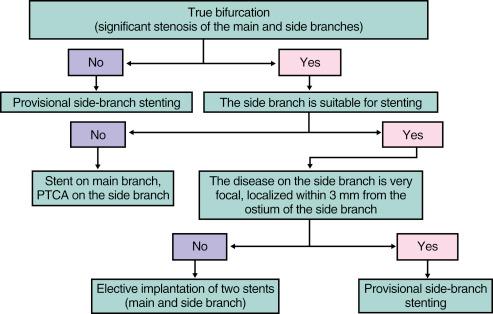
The most frequently used approach is provisional SB stenting, and it is outlined as follows:
Placement of two wires (MB and SB)
Predilatation of MB or both branches, when needed
Stenting of the MB
Stent optimization with proximal optimization technique (POT)
Recrossing with a wire into the SB
Crossing with a balloon into the SB
Performance of FKBI, with moderate pressure (8 atm) in the SB, until the balloon is fully expanded
Final POT, if result in the SB is adequate after FKBI
Placement of a second stent in the SB when the result is unsatisfactory (>75% residual stenosis, dissection, TIMI flow grade <3 in a SB ≥2.5 mm or FFR <0.80)
An important aspect when stenting bifurcations is the protection of the SB by inserting a wire to be left until the stenting procedure on the MB has been completed, including high-pressure stent deployment or postdilatation. During jailed wire retrieval, attention is paid to avoid any trauma to coronary ostium with the guiding catheter, which tends to be pulled in as jailed wire is removed.
In the provisional technique, wire cross through the distal strut (the “carina strut”) following MB stenting is strongly suggested because it creates better SB scaffolding than proximal crossing.
In order to optimize SB access through the carina strut, the POT technique is suggested. Optimization of the stent deployment proximal to the carina by using a short larger-diameter balloon may help access the most distal strut during wire exchange. If the result remains unsatisfactory after MB stenting, SB stenting should be performed with T stenting or TAP-stenting, reverse/internal crush or culotte, followed by kissing balloon inflation. Given the heterogeneity in local resource environment and operators level of experience, both of these variables may need to be taken into account when following the recommended general outlines for treatment of coronary bifurcation lesions.
After having attempted different types of wires with variations of curves and other advanced techniques, the operator may be left with the impossibility to advance a wire in the SB. At this point, a few options are available: (1) abort the procedure because the risk of closing the SB is too high, given the size and distribution of the branch (typically an angulated circumflex artery); (2) use a microcatheter in order to navigate a reshaped wire in unfavorable MV anatomies or the SuperCross catheter (Vascular Solutions, Minneapolis, MN) with different preshaped tip curves; (3) perform rotational atherectomy on the MV with the intent to remove the plaque, which prevents entry toward the SB; (4) dilate the MV with a balloon, hoping plaque modification will result in favorable plaque shift and facilitate access toward the SB; (5) use the “reverse wire” technique, creating a unique guidewire tip with two sharp curves (a longer proximal curve to create a loop in the distal MV and an opposite short distal curve to engage the SB ostium during the wire pullback); or (6) use the Venture wire control catheter (Vascular Solutions), a low-profile catheter with a tip that can be deflected up to 90 degrees to facilitate wire orientation and provide excellent backup support ( Fig. 23.4 ). Sometimes the use of a relatively stiff wire can be a solution, due to the better steerability and penetration force. Use of hydrophilic wires can also be considered; however, the risk of subintimal passage is increased when using stiff and/or hydrophilic wires.
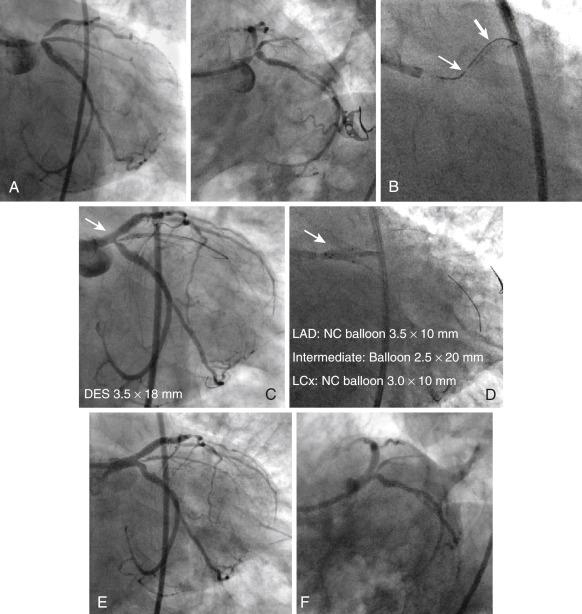
Each of these options has its rationale. The specific anatomical condition, the operator’s experience, and the clinical scenario may direct the selection of the best strategy.
FKBI is proposed if the SB is dilated through the MB stent struts to correct MB stent distortion and proximal expansion and provide better scaffolding of the SB ostium to facilitate future access to the SB. The long-term clinical benefit of FKBIs (in cases of MV stenting alone) is not proven. Nordic III and CORPAL-KISS studies demonstrated no systematic clinical advantage of routine kissing strategy when a single-stent treatment is used, and retrospective analysis of the COBIS (Coronary Bifurcation Stenting) registry found FKBI may even increase long-term TLR rate in the MV. However, angiographic follow-up at 8 months in the NORDIC III study showed lower SB restenosis rate in patients with true bifurcation lesions when FKBI was performed (7.6% vs. 20.0%, P = .024), and a study by Koo et al. found FKBI restores normal FFR in the SB in the majority of patients. A recent randomized study investigated the impact of angiography-guided versus FFR-guided SB treatment, in 320 patients undergoing bifurcation PCI with provisional SB stenting strategy. SB treatment (balloon or stent) tended to be less frequent in the FFR-guided group (56.3% vs. 63.1%, P = .07), and there was no difference in the 1-year rate of MACE or TVR. Several criteria have been proposed to define lesions in which FKBI is required (>75% residual stenosis at the SB, TIMI flow grade <3, or FFR <0.80). Therefore, two appropriate strategies are either to use a pressure wire to interrogate the significance of the SB lesion and treat or not accordingly, or simply to do FKBI on all angiographically significant ostial SB lesions, which reduces the proportion of physiologically significant SB ostial lesions. Of note, Nordic III found no penalty for routine kissing balloon inflations. A sequential MB-SB-MB balloon inflation was proposed as a simpler alternative to FKBI. A recent clinical, optical coherence tomography (OCT)-based study confirmed the previously in vitro observed benefits of this technique, which amounts to performing POT, followed by an SB dilatation and a repeated, final POT (rePOT). Although this study confirmed rePOT can be successfully applied in the clinical setting, its impact on patient outcomes needs to be further elucidated.
As a general approach to provisional strategy, we favor the performance of FKBI.
When we are not satisfied with the result obtained with balloon dilatation of the SB, we implant a second stent using one of the following strategies: T, TAP, culotte, or reverse/internal crush configuration. FFR or new imaging techniques, such as OCT, can be of value in the evaluation of SB result after balloon dilation.
T technique ( Fig. 23.5 ). This technique is the one most frequently utilized to transition from provisional stenting to stenting the SB. The T technique consists in advancing a second stent into the SB (following adequate dilation of the MB stent struts). The stent is positioned at the ostium of the SB trying to minimize any possible gap. A second kissing balloon inflation is also performed. In our view, the T technique is associated with the risk of leaving a small gap between the stent implanted in the MB and the stent implanted in the SB. This gap may be a factor contributing to an uneven distribution of the drug, hence leading to ostial restenosis at the SB.
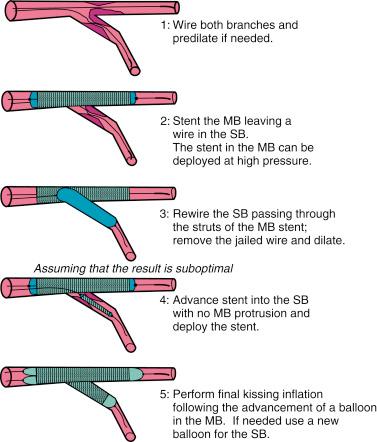
T stenting and small protrusion (TAP). The TAP technique is a modification of the T stenting technique and is based on an intentional minimal protrusion of the SB stent within the MB ( Fig. 23.6 ). This technique can be described as follows:
A second stent is advanced in the SB in a way to minimally protrude (1 or 2 mm) into the MB.
A balloon is advanced in the MB.
The SB stent is deployed as usual (12 atm or more), and the MB balloon is simultaneously inflated at 12 atm or more.
Both balloons are deflated and removed.
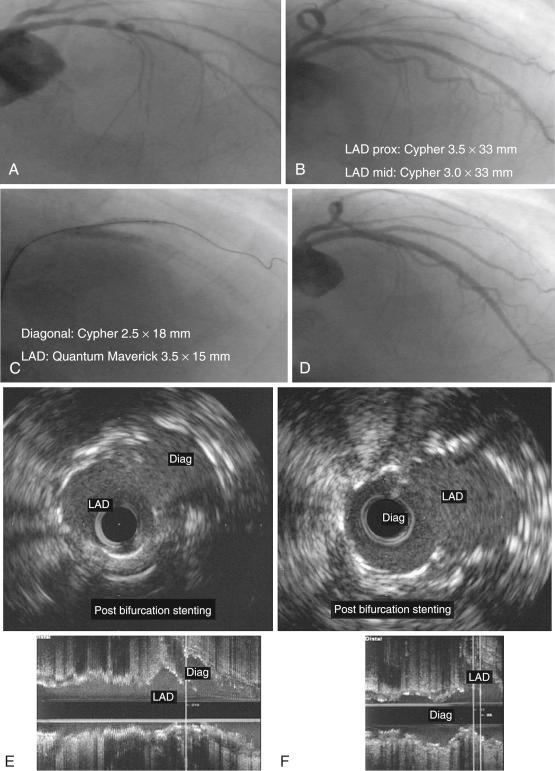
Despite some concerns about stent protrusion in the MB, in our experience we have been able to perform IVUS in the MB and SB and, when needed, to advance additional stents distally in the MB and in the SB. Three-year clinical follow-up of 95 patients treated with TAP stenting showed a MACE rate of 12.9%, and there were no cases of definite or probable ST.
Reverse/internal crush: crush performed after main branch stenting ( Fig. 23.7 ). The main purpose in performing a reverse crush is to allow an opportunity for provisional SB stenting. This technique was developed with the intent to minimize any possible gap between the MB and SB stents. The reverse crush can be performed utilizing a 6-Fr guiding catheter according to the following steps:
After stenting the MB, a second stent is advanced into the SB and left in position without being deployed.
A balloon sized according to the diameter of the MB, and shorter than the stent already deployed, is advanced in the MB and positioned at the level of the bifurcation, taking care to stay inside the stent previously deployed in the MB.
The stent in the SB is retracted about 3 mm or less into the MB and deployed. The deploying balloon is removed, and an angiogram is obtained to verify the absence of any distal dissection and the need of an additional stent. If such is the case, the wire from the SB is removed and the balloon in the MB is inflated at high pressure (12 atm or more).
The SB struts are recrossed with a wire and a balloon (a 1.5 mm balloon is sometimes needed). The balloon is sized to the SB reference diameter and inflated at high pressure (12 to 20 atm).
The final kissing balloon is performed.
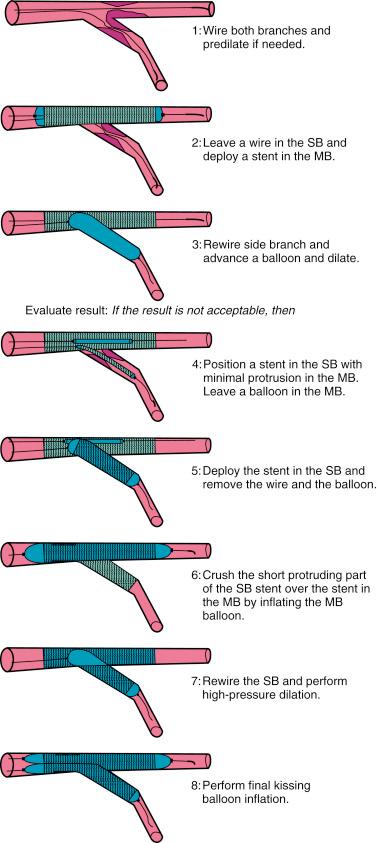
In our practice, this technique has been completely superseded by the TAP.
The provisional culotte technique. The culotte technique can be proposed as a provisional SB stenting strategy in Y shape angulated bifurcation lesions, as in the original description, although the first stent can be deployed across the most angulated branch, usually the SB (inverted culotte). This technique can be described as follows:
After MB stenting, a second stent is advanced in the SB protruding into the MB to overlap with the proximal part of the MB stent and expanded following removal of MB wire.
MB is rewired through the stent struts and dilated.
Finally, kissing balloon inflation is performed.
The European Bifurcation Club (EBC) was founded in 2004 in order to devise a common terminology for the description and treatment of bifurcation lesions and to exchange ideas on the clinical, technical, and fundamental aspects of the specific treatment strategies implemented in this setting. A synopsis of these discussions is presented as follows :
The MEDINA classification should be used for bifurcation lesions (1,0) and MADS classification for bifurcation stenting techniques (MADS: Main, Across, Distal, Side, based on the manner in which the first stent has been implanted).
Provisional T stenting remains the gold standard technique for most bifurcations.
Large SBs with ostial disease extending >5 mm from the carina are likely to require a two-stent strategy.
In provisional technique, after wiring both branches, the MB should be predilated when required, while SBs without severe calcification or long significant lesion (>5mm) do not require routine predilatation.
The SB wire should be jailed behind the MB stent in true bifurcation lesions.
The MB stent is selected according to distal MB diameter and postdilatation, or kissing balloon inflations, are required to optimize the proximal MB stent diameter.
The POT technique is carried out after MB stenting by inflating a short balloon just proximal to the carina; POT should be performed before SB rewiring to facilitate access and reduce the risk of accidental abluminal rewiring (wiring behind the MV stent).
SB treatment is indicated if the ostium is pinched or the flow is limited after POT.
SB wire crosses through the distal strut following MB stenting.
Kissing balloon inflation for carina reconstruction is optional in the provisional stenting but mandatory in two-stent techniques.
The procedure should be finalized by POT after kissing to correct the proximal MB stent distortion.
Intravascular imaging is a valuable supplement in bifurcation treatment and is especially useful in complex lesions due to the limitations of angiography alone.
Become a Clinical Tree membership for Full access and enjoy Unlimited articles
If you are a member. Log in here